|
|
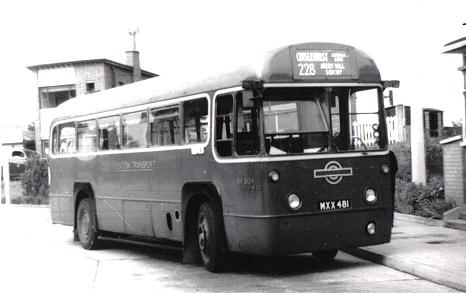 Red RF routes Red RF routes
Route 228
Page last updated 29 May 2020
Born from a 1928 single-deck route, the 228 was double-decked
in 1958 when road under the bridge at Sidcup was lowered.
Later briefly a Routemaster route, the service dwindled and was
replaced by other routes in 1996.
RF504 at Well Hall
Station, probably after its first overhaul in 1957. This bus stayed
at Sidcup from new until sent to Leyton when the 228 was converted
to RT.
Photo Peter Gomm
collection
Dates of RF operation
14 Jan 53 to 25 Nov 58
(total 5 years, 10 months, all crew
operation).
Destinations
CHISLEHURST Gordon Arms and ELTHAM Well Hall
Station
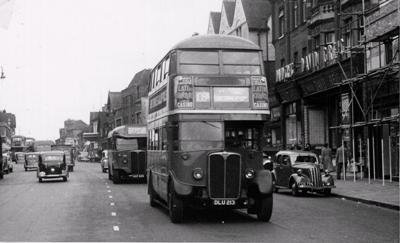 Reason for single-deck operation The 228 and 241 were single-deck operated due to a low
railway bridge at Sidcup Station, although the 228 was unusual (but
not unique, see also 212) in that
short-workings were double-deck operated. The road was
lowered under the bridge in 1958, allowing both routes to be
double-decked in their entirety. Peter Kennedy notes that the
road works were done rather on the cheap, with nothing more than
minimum excavations and fairly steep slopes on either side. To this
day it's a tight squeeze for double-deckers, and in recent years
there have been problems with artics and other long vehicles
straddling the dip and attacking the bridge from underneath.
Substantial steelwork has now been installed on either side,
ensuring that any damage is confined to the offending vehicles
rather than the bridge itself.
In Alan Cross's splendid
view of Eltham High Street in 1951, tunnel STL1844 on the 108A leads 14T12 T759 on the 228
heading west to the Well Hall Station terminus. In July 1951,
the 108 A was extended daily (from Eltham Rochester
Way, north of Well Hall) to Eltham Southend Crescent,
so that it overlapped with the 228 along Eltham High Street.
Perhaps with this being a new extension and maybe a new
short-working, the appropriate blind was not yet available - the
short-working 108 A destination of E Greenwich
Blackwall Lane is just south of the tunnel and the STL is
not going 'via Blackwall Tunnel' at all. Photo © Alan Cross,
courtesy Friends of Classic London Buses of the Fifties.
Route history
The route was born in November 1928, running from Chislehurst
to Sidcup Station under the number 195 and using one
single-deck K from Sidcup garage (SP). 1930 saw the K
replaced by a DA-class Dennis Dart, joined by another to
increase the service in September 1931 and by an LTL Scooter for
peak hour short workings in April 1932. The whole route
converted to Scooters in June, allowing the Darts to be sent to
Hounslow to start the 137 (later 237).
The route was withdrawn in November 1932 and replaced by an
extension of the 609 (later 229, then
254 and eventually the 126), but
reappeared in January 1934, now extended to Eltham Well Hall
Station. In October that year, the route was renumbered 228, now with an allocation of 7
LTLs from SP.
Long-time Sidcup resident
RT4076, working SP107, stands at Well Hall Station.
Photo © Paul Redmond
The 228 always operated between Chislehurst and Eltham,
from SP, but from April 1946, Monday to Friday peak hour
double-deck journeys were introduced between Sidcup
Station and Chislehurst Gordon Arms. The LT
Scooters lasted until August 1948, except for a couple that
lingered into 1949. From 1941 to 1946, they were replaced by
Qs on Sundays, when the 241 used many
fewer buses leaving the newer Qs available. With an influx of
further Qs from the Country Area, these progressively replaced
the LTLs, but were themselves soon replaced by post-war 14T12s in
1948. The handful of pre-war Ts of various types (3T3,
11T11, 1/7T7/1) that helped out at SP from time to time to
1951 worked on both the 228 and 241. Meanwhile, the
double-deck journeys were operated by LTs until 1948, then
RTLs.
The 14T12s lasted until 1953, when new RFs were introduced,
the first two running on 14 January and conversion was completed on
the 24th, with the spare bus RF422 being licensed on 28th.
The Ts went to replace 10T10s and TDs on the 211 at Southall (HW). In 1955, the
double-deck peak service was converted from RTL to RT.
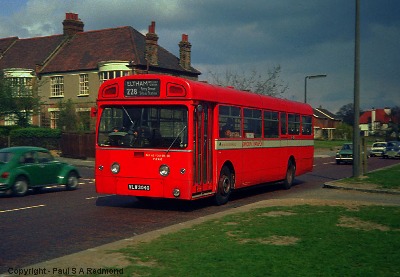 The
original 195 route from Chislehurst to Sidcup would have used
single-deckers because of limited traffic, but as soon as it was
extended to Eltham, they became a requirement due to the low bridge
at Sidcup Station. The road was finally rebuilt to improve
the clearance in 1958, whereupon Sidcup's single-deck routes (228
and 241) were converted to RT operation in November. The RFs
thus made available were sent to HW for 211, UX for 222 and AR/T for 236, enabling the retirement of the last 14T12s
and more TDs.
The RT conversion allowed the vehicle requirement to fall from
14 (peaks) to 11. However, in 1960 the route was
extended and split on Monday to Friday, the 228 running beyond
Eltham to Surrey Docks and the 228A to Blackwall
Tunnel. Routes 70 (part) and 108A were
replaced; New Cross operated half of the Monday to Friday
228. saturdays were added to the 228 extension on the
last day of 1966, with certain early journeys running to
London Bridge Station.
Single-deck again, but not
because of the bridge - this is a Sunday OMO working. MB304
on Bexley Road, Eltham, heading for Eltham Well Hall
Station. Peter Kennedy points out that the MBs, and the SMSs
that followed them, came from the 21A allocation at
Sidcup.
Photo © Paul Redmond
1968 saw a reversal. The 228A was withdrawn and the 228
cut back again to Eltham. The following year, the Sunday
service was converted to OMO MB, replaced by SMS in 1973. In
1975, Saturday operation was replaced by RMs, with the RTs retiring
finally in 1977. The weekday service went OMO with DMSs in
January 1978, the DMSs having replaced the Sunday Swifts in
1976.
Leyland Titans started taking over from the DMSs in
late 1982.
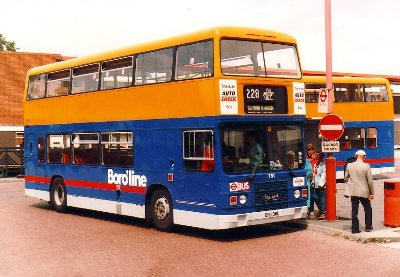 In 1984 was the route cut back from
Chislehurst to Sidcup Garage off-peak and Saturdays and withdrawn
on Sundays. November 1986, now with joint T and L
operation, saw the combination of the 228 and the
61 B (a new Chislehurst to Eltham route introduced three
months earlier) to form a circular, 228 A anti-clockwise
and 228 C clockwise.
At first, when the 61B arrived at Chislehurst
War Memorial, the passengers were told to get off as the
bus finished there. When every one had got off, the driver got out
of the cab to change all blinds to 228 to Eltham. Thus customers
wanting to go through to Sidcup had to reboard and pay again.
The 228/61B blind change occurred in the other direction
- it was always in effect a circular route. The union
instigated the change to 228A/C, which made
more sense.
The 228 did reappear, from 1988 to 1996, as a
renumbering of the 228C (the 228A became the
328) and operated by Boro'line (Maidstone). In 1996, the
route was replaced by the 160 and 233.
Boro'line Olympian no.
751
Photo © Jason Jones, Ian
Armstrong collection
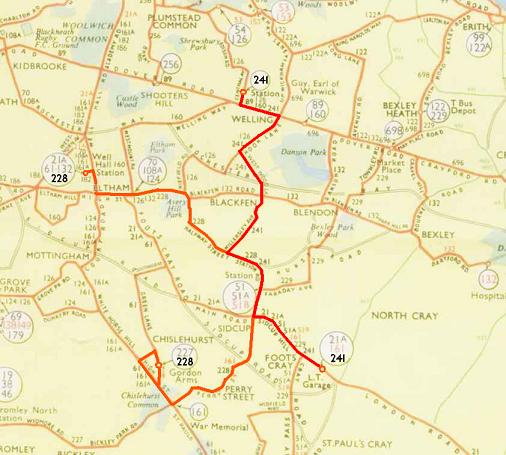 RF route in detail, with timing points RF route in detail, with timing points
CHISLEHURST Gordon Arms, Edward Road, Green Lane,
Heathfield Lane, Loop Road, (return via Chislehurst High Street,
Albany Road, Green Lane), Centre Common Road, Chislehurst War Memorial, Bromley
Lane, Perry Street, Perry Street
Beaverwood Rd, Perry Street, Chislehurst Road, Elm
Road, Sidcup Police
Station, Station Road, Sidcup Station, Halfway Street, Avery Hill
Road, Bexley Road Avery Hill
Road, Bexley Road, Eltham High Street, Eltham High Street, Eltham
Church, Well Hall Road, ELTHAM Well Hall
Station.
Terminal working at Well Hall Station: on 1 Jul 52, the former
terminal loop from Eltham High Street via Sherard Road to stand was
replaced by a new bus station between Well Hall Station and Sherard
Road; accessed from and to Well Hall Road via Sherard
Road. This bus station was replaced in 1985 on construction
of the Rochester Way Relief Road and the new Eltham Station.
Garage journeys from SP: Foots Cray High Street, Sidcup Hill
to line of route at Sidcup
Frequency
| Year |
Mon-Fri |
Sat |
Sun |
| 1936 |
10-15 mins |
10-15 mins |
10-15 mins |
| 1938 |
10-15 mins |
10-15 mins |
15 mins |
| 1941 |
10-15 mins |
10 mins |
15 mins |
| 1946 |
10-12 mins |
7-10 mins |
10-12 mins |
| 1951 |
6-8 mins |
6-10 mins |
8-12 mins |
| 1953 |
6-8 mins |
5-10 mins |
8-12 mins |
| 1959 |
7-15 mins |
8-15 mins |
15 mins |
The route took 30-32 minutes from end to end.
Faretable
A much later faretable (1977) is here.
RF allocation
New RFs delivered Jan 53: 409,411, 416-422, 439, 455
plus 290, 297, 300 ex-trainers (total 13 + 1
spare). See also the 241.
PVR 1953: Mon-Fri 13 +1 RTL peaks, Sat 13, Sun 9
PVR 1955 (Oct): Mon-Fri 13 +1 RT peaks, Sat 13, Sun
9
PVR 1956 (Oct): Mon-Fri 13 +1 RT peaks, Sat 13,
Sun 8
PVR 1957 (Oct): Mon-Fri 13 +1 RT peaks, Sat 13,
Sun 7
PVR 1958 (Apr): Mon-Fri 13 +1 RT peaks, Sat 13,
Sun 8
PVR 1958 (Oct): Mon-Fri 13 +1 RT peaks, Sat 13,
Sun 7
1955 bus map showing the
Sidcup RF routes 228 and 241.
Map © London
Transport
Re-creation
The 228 and 241 were operated by RFs at the Sidcup and
Swanley Running Day in 2007. At Chislehurst, RF486 reflects
on progress (photo © Peter Osborn).
|
|